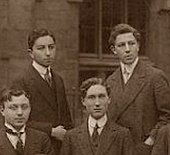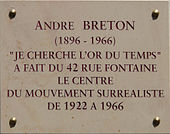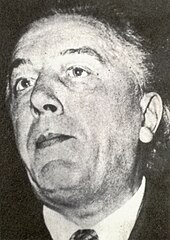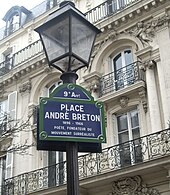André Breton
André Breton (born February 19, 1896 in Tinchebray , canton Tinchebray , Orne département in Normandy , † September 28, 1966 in Paris ) was a French poet , writer and the most important theoretician of surrealism ; his whole life was connected with this movement.
Life
childhood
André Breton was born in Tinchebray , the son of a police officer . In 1900 the family settled in Pantin near Paris. After attending the École communale, he was a student of the Lycée Chaptal from 1906 to 1912, and from 1913 attended the Higher Technical College as preparation for a medical degree.
The years up to 1924
In 1913 he met the writer Paul Valéry , he wrote poetry, impressed by Stéphane Mallarmé and other authors of symbolism . In 1915, after starting medical school, he was drafted into the medical service, met Jacques Vaché in Nantes , and worked intensively with Arthur Rimbaud ; he worked in a psychiatric institution and read the works of Sigmund Freud , whom he was to visit in Vienna in 1921 . In 1918 he met Guillaume Apollinaire and discovered the wild poetry of the Comte de Lautréamont . He dropped out of medicine to become a freelance writer. In 1919 he founded the magazine Littérature with Louis Aragon and Philippe Soupault , which was close to Dadaism . In 1919 Tristan Tzara also came to Paris from Zurich , and the group of Parisian Dadaists grew steadily when Paul Éluard , Max Ernst , Robert Desnos , René Crevel and Benjamin Péret joined them . The unconscious was explored, it was the time of " automatic writing " ( écriture automatique ), hypnosis experiments and dream protocols . On September 15, 1921, he married the Strasbourg banker's daughter Simone Kahn ; the couple moved to rue Fontaine 42 in Paris. The shared apartment remained Breton's domicile even after the divorce in 1931.
Surrealism until the war
In 1924 he wrote the Manifesto of Surrealism , in which he defined surrealism as a "pure psychological automatism". Organ of the new group was the magazine La Révolution surréaliste (twelve issues 1924–1929). Growing political interest brought him and the group close to the communists, and finally, in 1927, alongside André Breton, Louis Aragon, Paul Éluard, Benjamin Péret and Pierre Unik joined the PCF .
In 1928 he wrote his most successful book to date: the experimental novel Nadja . With Le Surréalisme et la Peinture (Surrealism and Painting) he tried to provide a theoretical foundation for surrealist painting, for which he cited Max Ernst, Pablo Picasso , Joan Miró and André Masson as examples . In 1929, at the suggestion of Joan Miró , Salvador Dalí joined the group of surrealists in Paris; However, Dalí was excluded from the group in 1939 after lengthy arguments. In 1930 Breton tried to redefine surrealism as a social revolutionary movement in the Second Manifesto of Surrealism : “ Marx says change the world. Rimbaud says, change life. ”- Surrealism is the synthesis of these two ideas, he committed himself to the“ social and psychological revolution . ”In the work L'Immaculée Conception , written together with Paul Éluard, the two tried one textual-poetic simulation of delusional states from Freudian psychoanalysis . Breton dealt intensively with the contrast between "being awake" and "dream" in his 1932 work Les vases communicants (The communicating tubes). a. also contains a short correspondence with Sigmund Freud . After an affair with Valentine Hugo from 1930 to 1932, Breton married the painter Jacqueline Lamba in August 1934 . Groomsmen were Alberto Giacometti and Paul Éluard . The encounter with her was reflected in his work L'Amour fou from 1937.
The group's newly founded newspaper was program: Le Surréalisme au service de la révolution (Surrealism in the service of the revolution, six issues, 1930–1933). But Breton and his friends had more and more problems with party dogmatics, and in 1935 the tensions culminated in the final break with the PCF . André Breton became a critic of Stalinism ; it was the time of the Spanish Civil War in which some of the Surrealists (such as Benjamin Péret and Tristan Tzara) took part on the republican side. In the same year, the Austrian painter and theorist Wolfgang Paalen joined Breton's movement.
In 1936, Breton and Georges Bataille founded a group of left-wing revolutionary intellectuals that later became known as "Contre-Attaque". In the same year he was involved in organizing the International Surrealist Exhibition at the New Burlington Galleries in London . A year later, Breton opened a surrealist gallery under the name “ Gradiva ” at 31 rue de Seine, but it was closed again after a short time. Marcel Duchamp designed the entrance to the gallery, the glass door of which was decorated with a silhouette of a couple walking arm in arm.
In 1938 Breton organized, together with Paul Éluard, Wolfgang Paalen, Marcel Duchamp and Man Ray , the Exposition Internationale du Surréalisme in the Galerie Beaux-Arts in Paris . In the same year Breton met Leon Trotsky in his exile in Mexico with Diego Rivera : Together they wrote the manifesto Pour un art révolutionnaire indépendant (For an independent revolutionary art). In the meantime Surrealism was known and active far beyond the borders of France , with groups and manifestations in Brussels , Barcelona , London or Prague . In 1940 he organized the Exposición internacional del surrealismo in the Galería de Arte Mexicano by Inés Amor with Wolfgang Paalen and César Moro .
War, exile, return
After the occupation of France by the German Wehrmacht , Breton and Jacqueline fled from Marseille to New York via the Antilles in 1941 with financial support from the art collector Peggy Guggenheim . There he met Marcel Duchamp and Max Ernst, from 1942 they published in the magazine VVV, which was jointly edited with David Hare . With Duchamp, Breton organized the surrealist exhibition First Papers of Surrealism . In the same year he separated from his wife; Breton married Elisa Claro-Bindhoff (1906-2000) for the third time in 1945 , while Jacqueline married David Hare in 1946. During this time Breton dealt with pre-Columbian America and the early socialists, especially with Charles Fourier .
After the war, Breton returned to Europe in 1946, his hopes for a new social and political beginning were disappointed. Parts of the group, such as Louis Aragon and Paul Éluard, had since joined the Moscow-friendly party line. Together with Jean Dubuffet , Breton founded the Compagnie de l ' Art Brut association in 1947 to promote and exhibit outsider art , but fell out with him in 1951. In the first post-war years, he had problems in the cultural scene in particular due to the opposition of the Stalinists To provide; that changed when he organized a comprehensive international surrealism exhibition Le Surréalisme en 1947 at the Maeght Gallery .
In 1960 Breton became involved against the Algerian war . In the following decade, the writer, criticized as the "Pope of Surrealism", continued to make the movement heard, for example with the anthologies L'Art magique (1957), Le Surréalisme et la Peinture (1965) and the organization of international surrealism exhibitions: EROS (1959/1960) and the last major exhibition in 1965, the title of which stands like a program for him and surrealism : “L'écart absolu”: the absolute deviation.
In 1966 André Breton died of a lung disease and was buried on the Cimetière des Batignolles in the Quartier des Batignolles on the outskirts of Paris. The city of Paris gave it its name in honor of a square in the 9th arrondissement .
estate
In 2003 the apartment at 42 rue Fontaine had to be given up by Aube Elléouët - Breton's daughter from the marriage to Jacqueline Lamba - after the death of her stepmother Elisa. The plan of a foundation failed due to the lack of interest of the French state despite considerable objections from artists, writers and intellectuals who tried to prevent the auction with letters of protest and appeals. Their goal was to preserve one of the most important private collections of surrealist art treasures. Breton had decorated his apartment with paintings by Surrealist artists, oceanic masks, Mexican votive tablets, stuffed birds of paradise, books, photographs, and found objects for over 40 years, and it was a regular gathering place for Surrealist writers and artists. As a museum, however, it would have been too small. The ensemble in its peculiar atmosphere can be seen in a film that Fabrice Maze made in 1994 for the Center Pompidou.
The collection, divided into 5400 lots, was auctioned at the Hôtel Drouot in April of that year . In order to be able to pay the inheritance tax, the Center Pompidou was given a representative section of the collection as well as the personal correspondence of Breton. The Center Pompidou used this part of the estate to create a wall behind glass that can be viewed in the museum.
Works
- Mont de piété ( Pawnshop ), Poems (1919)
- Les Champs magnétiques ( The magnetic fields ) with Philippe Soupault (1920)
- Clair de Terre ( Earth Shine ), Poems (1923)
- Manifeste du Surréalisme ( The Manifesto of Surrealism ) (1924)
- Poisson Soluble ( Soluble Fish ) ( integral part of the manifesto ) (1924)
- Nadja (1928; revised 1962)
- Le Surréalisme et la peinture ( Surrealism and Painting ) (1928)
- Ralentir Travaux ( attention construction site ) with René Char and Paul Éluard (1929)
- Second Manifeste du Surréalisme ( The Second Manifesto of Surrealism ) (1930)
- L'Immaculée Conception ( The Immaculate Conception ) with Paul Éluard, illustrated by Salvador Dalí (1930)
- Les Vases communicants ( The Communicating Tubes ) (1932)
- Le revolver a cheveux blancs ( The white-haired revolver ), poems (1932)
- Le Message automatique ( The Automatic Message ), essay (1933)
- L'air de l'eau ( The Way of Water ), poems (1934)
- L'Amour fou (1937)
- Pour un art indépendant révolutionnaire ( For an independent revolutionary art ) with Leon Trotsky (1938)
- Anthologie de l'humour noir ( anthology of black humor ) (1940)
- Prolégomènes à un troisième manifeste ou non ( preface to a third manifesto or not ) (1942)
- Arcane 17 ( Arkanum 17 ) (1944)
- Ode à Charles Fourier ( Ode to Charles Fourier ) (1945)
- Entretiens ( Entretiens - Talks ) (1952)
- La Clé des champs ( Looking Away ) (1953)
- Constellations ( constellations ), prose poems gouaches by Joan Miró (1959)
Annotated work edition
- André Breton: Œuvres complètes Vol. 1–3, Ed. Marguerite Bonnet, Bibliothèque de la Pléiade, Paris: Gallimard 1987–1999 (another volume in preparation) ISBN 2-07-011138-5 (Vol. 1); ISBN 2-07-011234-9 (Vol. 2); ISBN 2-07-011376-0 (Vol. 3) (older complete edition: Gallimard, 1952)
German
- The manifestos of surrealism. German by Ruth Henry. 27. Th. Rowohlt, Reinbek bei Hamburg 1993, ISBN 3-499-55434-8
- Nadja . Translation and epilogue by Max Hölzer . Neske, Pfullingen 1960 (Volume 406 of the Suhrkamp Library , 1974, ISBN 3-518-01406-4 ).
- Anthology of Black Humor . Edited and foreword by André Breton (1939), Rogner & Bernhard, Munich 1979. Text collection with contributions by (and with introductory words by André Breton about) Jonathan Swift , Marquis de Sade , Georg Christoph Lichtenberg , Charles Fourier , Thomas de Quincey , Pierre-Francois Lacenaire , Christian Dietrich Grabbe , Petrus Borel , Edgar Allan Poe , Xavier Forneret , Charles Baudelaire , Lewis Carroll , Villiers de L'Isle-Adam , Charles Cros , Friedrich Nietzsche , Joris-Karl Huysmans , Comte de Lautréamont , Arthur Rimbaud , Alphonse Allais , Jean Pierre Brisset , O. Henry , JMSynge , André Gide , Francis Picabia , Guillaume Apollinaire , Pablo Picasso , Jakob van Hoddis , Hans Arp , Marcel Duchamp , Jacques Vaché , Alfred Jarry , Franz Kafka , Salvador Dalí , Gisele Prassinos , Jean-Pierre Duprey , Jacques Rigaut , Jacques Prévert , Leonora Carrington u. a. The anthology's EA appeared in 1940, four days before the fall of Paris. The issue was banned by the Petain government. The next two editions appeared in 1945 and 1950 with increased content.
Magazines
He wrote for the magazines La Révolution surréaliste , Contimporanul , Minotaure and VVV , among others .
literature
- Volker Zotz : André Breton. Rowohlt, Reinbek 1990, ISBN 3-499-50374-3 (abridged version compared to the French edition Somogy, Paris 1991, ISBN 2850561991 )
- Mark Polizzotti : Revolution of the Mind. The life of André Breton. From the American by Jörg Trobitius. Hanser, Munich 1996, ISBN 3-446-16548-7
Further literature
- Rita Bischof: Nadja revisited . Brinkmann and Bose, Berlin 2013, ISBN 978-3-940048-19-6 .
- Susanne Goumegou: Dream Text and Dream Discourse: Nerval, Breton, Leiris . Fink, Munich 2007.
- On Contre-Attaque: Stephan Moebius, Die Zauberlehrlinge. Sociological history of the Collège de Sociologie 1937–1939. Constance: UVK, 2006. ISBN 3-89669-532-0 ; Patrick Kilian: Georges Bataille, André Breton and the Contre-Attaque group. About the “wild thinking” of revolutionary intellectuals in the interwar period. Röhrig, St. Ingbert 2013, ISBN 978-3-86110-530-5 .
Web links
- Literature by and about André Breton in the catalog of the German National Library
- Works by and about André Breton in the German Digital Library
- Breton's voice in the interview
Individual evidence
- ↑ Volker Zotz: Breton . Rowohlt, Reinbek 1190, p. 14 ff
- ↑ Angelika Heinick: Jacqueline Lamba: Known as the wife of Breton, forgotten as an artist: A film about Jacqueline Lamba. faz.net, August 17, 2006, accessed August 5, 2010 .
- ↑ Calvin Tomkins: Marcel Duchamp. A biography , Carl Hanser, Munich 1999, p. 363 f
- ↑ Biography Jacqueline Lamba, accessed on August 5, 2010 ( Memento from July 9, 2015 in the Internet Archive )
- ↑ Calvin Tomkins: Marcel Duchamp. A biography , Carl Hanser, Munich 1999, p. 387 f.
- ↑ Leona Frommelt: Ausverkauf einer Mythos , dw.de, accessed on June 15, 2013
- ↑ Treasure in bites. Sale in Paris: The apartment of surrealist André Breton is being closed , zeit.de, 2/2003, accessed on June 14, 2013
- ^ L'Atelier d'André Breton , centrepompidou.fr, accessed June 14, 2013
| personal data | |
|---|---|
| SURNAME | Breton, André |
| BRIEF DESCRIPTION | French poet, writer and theorist of surrealism |
| DATE OF BIRTH | February 19, 1896 |
| PLACE OF BIRTH | Tinchebray , Canton Tinchebray , Orne Department , Normandy |
| DATE OF DEATH | September 28, 1966 |
| Place of death | Paris |








